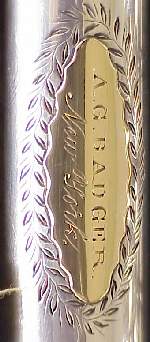

 |
A. G. Badger
|
 |


|
Above you can see that the low B-flat
is actuated
by the long L4 mechanism (sorry about the photo splices) that clutches
to the footjoint at the tenon to connect to the even longer Bb
shaft.
The venting of the Bb tonehole is adjusted by means of a kicker under
the
D# touch opposite the clutch. The venting of the B, C and C#
toneholes
is set with a knurled adjuster incorporated onto the B connector.
The C and C# pad cups open until stopped by the B touch in the R4
cluster.
|
 Nostril View
Nostril View

Navel View
 Beneath the metal plating the wood crown is female threaded to mate with the wooden screw cork adjuster and perforated for the metal cork position indicator. |
 The wood barrel embouchure is sandwiched between the headjoint tube and a metal sleeve. The wood is visible here looking into the very oval blow hole. Not as smooth and polished as it was 130 years ago, but it still generates a sweet sound. |
 A R1 trill touch for G# is created with a fluid continuation of the L4 touch as it passes beneath the in-line G pad cup. The other R1 touch is a B-C shake. |
This flute passed from father to son to grandson -- and then grandson got the dang fool notion that girls were more fun than flutes, and into the closet it went for the next 35 years!
A special thanks to Peter Spohr's article on
early
American Boehm flutes in the Journal of the American Musical
Instrument
Society (Volume XXV) for his description and commentary on another
Badger flute, and to Jim Gleason of Old World Music for his assistance
in bringing the flute back into playing condition. Check the similar A.
G. Badger flute on David and Nina Shorey's Field Guide to
Antique
Flutes (and enjoy their double-tongue-in-cheek speculation as to
its
provenance)!
Images © J.
W. Sallenger